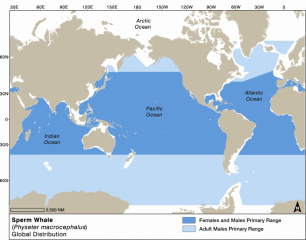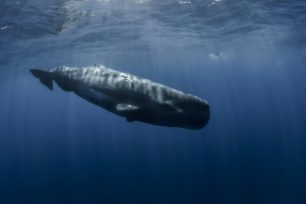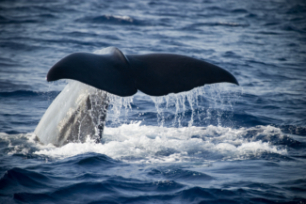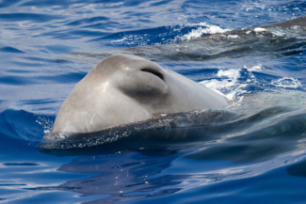Sperm whales are the largest toothed cetacean. The size of most large baleen whales, they actually have teeth on their bottom jaw, used to grasp large squid or fish, unlike other large whales that filter smaller denser prey through their baleen. Almost mythical creatures, sperm whales were historically feared and revered in cultures around the world. The famous 19th century novel, Moby Dick, featured a sperm whale, and was based on the experiences of ‘Yankee whalers’ that roamed the world’s oceans hunting whales from small open boats in the 1800’s. Though not the largest species of whale, it does have the largest head and the largest brain of any animal on the planet; can dive deeper than almost any other marine mammal; and lives in a stable and complex matrilineal society similar to that of elephants. Sperm whales are usually found in deep oceanic waters, but can be observed closer to shore around islands or areas where underwater canyons or a narrow continental shelf provide deep water nearshore habitat.
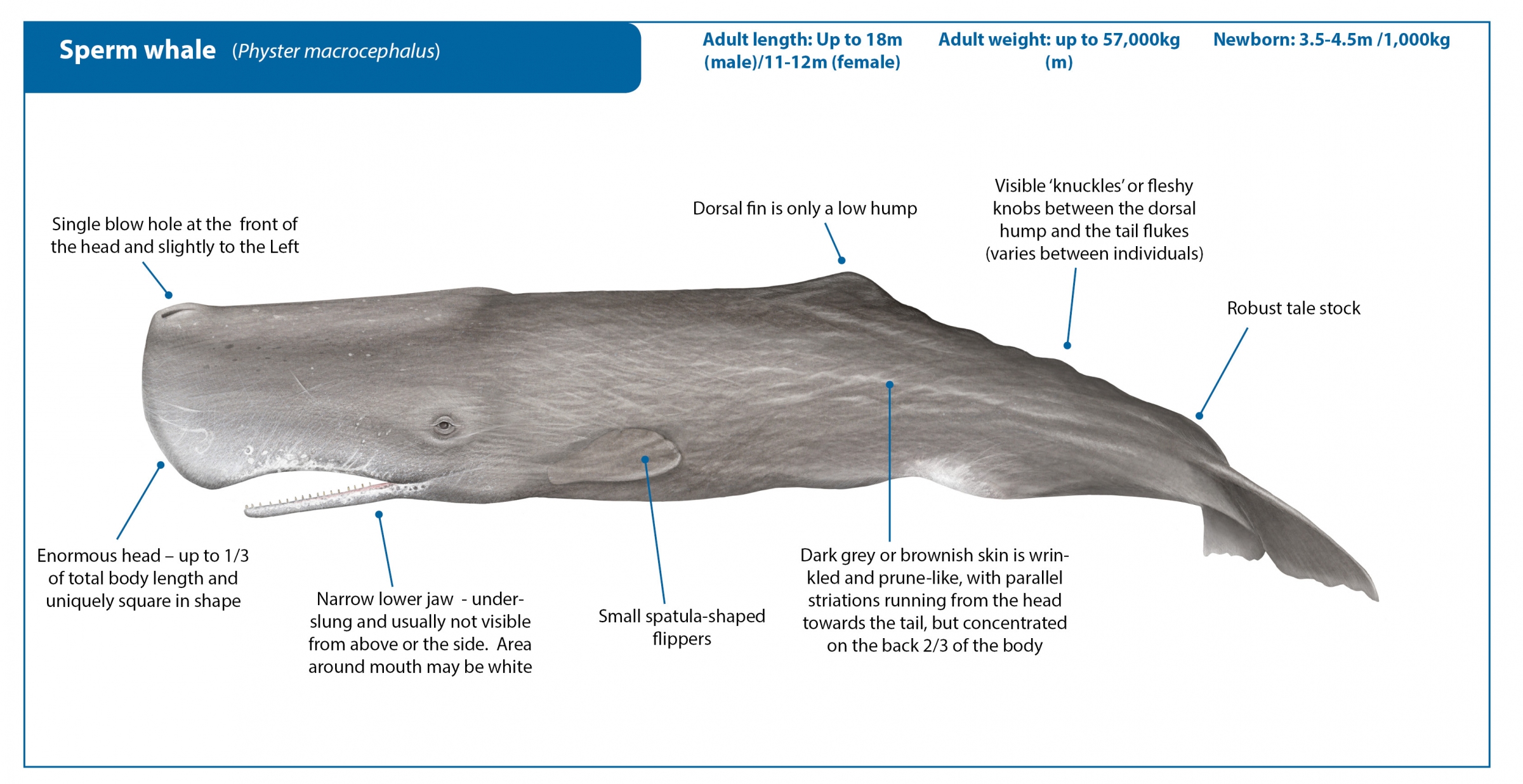

References
Show / Hide References
- Whitehead, H., Sperm Whale, Physeter macrocephalus, in Encyclopedia of Marine Mammals, W. Perrin, B. Wursig, and J.G.M. Thewissen, Editors. 2009, Elsevier: San Francisco. p. 1091-1097.
- Taylor, B.L., et al., Physeter macrocephalus in IUCN Red List of Threatened Species. 2008, http://www.iucnredlist.org/details/41755/0 Downloaded on 9 October 2017.
- Mirceta, S., et al., Evolution of Mammalian Diving Capacity Traced by Myoglobin Net Surface Charge. Science, 2013. 340(6138).
- Whitehead, H., The behaviour of mature male sperm whales on the Galapagos breeding grounds. Can J Zool, 1993. 71.
- Childerhouse, S. and S.M. Dawson, Stability of fluke marks in individual photoidentification of male sperm whales at Kaikoura, New Zealand. 1996. p. 447-451.
- Frantzis, A., P. Alexiadou, and K.C. Gkikopoulou, Sperm whale occurrence, site fidelity and population structure along the Hellenic Trench (Greece, Mediterranean Sea). Aquatic Conservation: Marine and Freshwater Ecosystems, 2014. 24(S1): p. 83-102.
- Gero, S. and H. Whitehead, Critical Decline of the Eastern Caribbean Sperm Whale Population. PLoS ONE, 2016. 11(10): p. e0162019.
- Engelhaupt, D., et al., Female philopatry in coastal basins and male dispersion across the North Atlantic in a highly mobile marine species, the sperm whale (Physeter macrocephalus). Molecular Ecology, 2009. 18(20): p. 4193-4205.
- Whitehead, H., Gene–culture coevolution in whales and dolphins. Proceedings of the National Academy of Sciences, 2017. 114(30): p. 7814-7821.
- Watkins, W.A., et al., Sperm whale dives tracked by radio tag telemetry. Marine Mammal Science, 2002. 18(1): p. 55-68.
- Ponnampalam, L., No Danger in Sight? An Observation of Sperm Whales (Physeter macrocephalus) in Marguerite Formation off Muscat, Sultanate of Oman. Aquatic Mammals, 2016. 42(2): p. 162-167.
- Di Natale, A. and G. Notarbartolo-di-Seiara, A review of the passive fishing nets and trap fisheries in the Mediterranean Sea and of the cetacean bycatch. 1994. p. 189-202.
- García-Godos, I., et al., Entanglements of large cetaceans in Peru: few records but high risk. Pacific Science, 2013. 67(4): p. 523-532.
- Haase, B. and F. Felix, A note on the incidental mortality of sperm whales (Physeter macrocephalus) in Ecuador, in Gillnets and Cetaceans, W.F. Perrin, G. Donovan, P., and J. Barlow, Editors. 1994, Report of the International Whaling Commission: Cambridge, U.K. p. 481-484.
- de Stephanis, R., et al., As main meal for sperm whales: Plastics debris. Marine Pollution Bulletin, 2013. 69: p. 206–214.
- Jacobsen, J.K., L. Massey, and F. Gulland, Fatal ingestion of floating net debris by two sperm whales (Physeter macrocephalus). Marine Pollution Bulletin, 2010. 60: p. 765–767.
- Carrillo, M. and F. Ritter, Increasing numbers of ship strikes in the Canary Islands: proposals for immediate action to reduce risk of vesselwhale collisions. Journal of Cetacean Research and Management, 2010. 11(2): p. 131–138.
- De Stephanis, R. and E. Urquiola, Collisions between ships and cetaceans in Spain. Document presented to the Scientific Committee of the International Whaling Commission SC/58/BC5, 2006.
- Fais, A., et al., Abundance and Distribution of Sperm Whales in the Canary Islands: Can Sperm Whales in the Archipelago Sustain the Current Level of Ship-Strike Mortalities? PLoS ONE, 2016. 11(3): p. e0150660.
- Frantzis, A., et al., Update on sperm whale ship strike risk in the Hellenic Trench, Greece. Report presented to the Scientific Committee, of the International Whaling Commission 2015. SC/66a/HIM06(Sand Diego, California): p. 6.
- Rendell, L. and A. Frantzis, Mediterranean Sperm Whales, Physeter macrocephalus: The Precarious State of a Lost Tribe, in Advances in Marine Biology. 2016, Academic Press.
- Laist, D.W., et al., Collisions between ships and whales. Marine Mammal Science, 2001. 17(1): p. 35-75.
- Notabartolo di Sciara, G., et al., Physeter macrocephalus (Mediterranean subpopulation), in IUCN Red List of Threatened Species. 2012, http://www.iucnredlist.org/details/16370739/0 Downloaded on 9 October 2017.
- Dawson, S.M., Distribution, abundance and population structure of Sperm Whales at Kaikoura 1996, WWF. p. 2-32.
- Gordon, J., et al., Effects of whale-watching vessels on the surface and underwater acoustic behaviour of sperm whales off Kaikoura, New Zealand, in Science & Research Series No. 52. 1992, Department of Conservation: Wellington, New Zealand.
- Richter, C., S. Dawson, and E. Slooten, Impacts of commercial whale watching on male sperm whales at Kaikoura, New Zealand. Marine Mammal Science, 2006. 22(1): p. 46-63.
- Ritter, F., Abundance, distribution and behaviour of cetaceans off La Gomera (Canary Islands) and their interaction with whale-watching boats and swimmers, in Master's Thesis. University of Bremen. Bremen, Germany. 1996.

